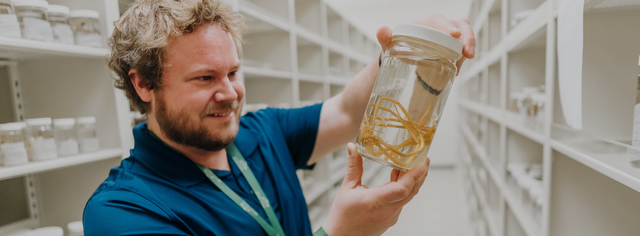The collections at the Virginia Museum of Natural History continue to grow, in keeping with the mission and purposes of the Museum: "to interpret Virginia's natural heritage within a global context in ways that are relevant to all the citizens of the Commonwealth, . . . to preserve elements of natural history, to serve as a permanent repository for specimens, especially those of Virginia origin, and to make the natural history material and its data accessible to researchers and the public."
The collections provide the basis for both in-house research and research that extends nationally and internationally.
"Natural History collections are very important to our understanding of the world around us. When specimens are well cared for and well documented, they can provide a wealth of information to researchers in such areas as climate change, biodiversity, evolution, and more. The most important parts of a natural history collection are its type specimens, which are those specimens that were used to describe and name a species and are considered to be the standard representation of that species. When researchers find what they believe to be new species, they can compare them to the type specimens of similar species in order to ensure that the find is truly something that hasn't been described before."
-Haley Cartmell, collections manager at VMNH
VMNH Collections Quick Facts
- The Virginia Museum of Natural History has over 10 million specimens in its collections.
- The VMNH collections include specimens in the areas of Archaeology, Bryozoans, Earth Science, Amphibians and Reptiles, Recent Invertebrates, Invertebrate Fossils, Birds, Mammals, Frozen Tissues, Plant Fossils, and Vertebrate Fossils.
- The VMNH collections include 173 type specimens. Type specimens are the specimen, or each of a set of specimens, on which the description and name of a new species is based.
- VMNH staff are directly responsible for the naming of 520 species new to science.
Collection Areas
For more information about the museum collections, please contact Jill Harris, Registrar, at jill.harris@vmnh.virginia.gov.
Archaeology
- Over 450,000 cataloged specimens and samples, more than 1,700 cataloged slides from Martinsville and Henry County site excavations by Richard P. Gravely
- Individuals or companies wishing to transfer archaeology collections to VMNH should follow the guidelines (including management fee) established by the Department of Historic Resources. Download the Virginia Department of Historic Resources State Collections Management Standards.
- Download the archaeology collections database (Last updated: 1/26/2023)
Bryozoans
- Approximately 200 species and about 5,000 cataloged specimens
- Species named: 59
- Genera named: 8
- Higher taxa: 4 families
- Holotypes in the collections: 4
- Paratypes in the collections: 15
- The bryozoans collection database can be accessed within the recent invertebrates collection database. (Last updated: 1/26/2023)
Earth Science
- Approximately 5,000 pieces and 70,000 feet of core
- Download the earth science collection database (Last updated: 1/26/2023)
Education
- More than 3,000 items, 1,500 slides, and more than 300 taxidermy mounts
- Download the education collection database (Last updated: 1/26/2023)
Amphibians and Reptiles
- More than 10,300 cataloged specimens
- For a copy of the herpetology specimen records, please contact Assistant Curator of Herpetology, Dr. Arianna Kuhn
Paleontology
- Visit the VMNH Paleontology Collection webpage
- Download the paleontology collection database (Last updated: 1/26/2023)
Invertebrate Fossils
- More than 10,000,000 specimens
- Species named: 50
- Genera named: 12
- Types in the collections:
- Triassothrips virginicus (holotype, 3 paratypes, genotype and basis for Family Triassothripidae; all known specimens housed at VMNH
- Metarchilimonia krzeminskorum (holotype, paratype, genotype)
- Metarchilimonia solita (holotype)
- Triassopsychoda olseni (holotype, genotype)
- Yalea rectimedia (holotype)
- Virginiptera certa (holotype, paratype, genotype)
- Virginiptera similis (holotype, paratype)
- Virginiptera lativentra (holotype)
- Brachyrhyphus distortus (holotype, genotype)
- Crosaphis virginiensis (holotype)
- Prosechamyia trimedia (holotype, genotype and basis for Family Prosechamyiidae)
- Prosechamyia dimedia (holotype)
- Argyrarachne solitus (holotype, genotype)
Plant Fossils
- Approximately 1,300 pieces with 212 blocks with samples
- Types in the collections:
- Pannaulika triassica (holotype and genotype)
- Fraxinopsis aquilonaris (holotype and paratype)
Vertebrate Fossils
- More than 5,000 items and 955 unprocessed lots
- Species named (author or coauthor): 3
- Genera named (author or coauthor): 2
- Types in the collections:
- Eobalaenoptera harrison
- Mecistotrachelos apeoros (holotype and paratype - only four specimens known)
- Agnosphitys cromhallensis (holotype and paratypes; all known specimens housed at VMNH)
Birds
- Approximately 11,000 skins, approximately 9,000 eggs, and about 650 nests
- Download the birds collection database (Last updated: 1/26/2023)
Mammals
- More than 20,000 specimens
- Download the mammals collection database (Last updated: 1/26/2023)
Recent Invertebrates
- More than 1,500,000 specimens
- New species: about 405
- New genera: about 200
- Higher taxa: about 40 tribes, 25 subfamilies, seven families
- Holotypes in VMNH: about 150 (mostly millipeds, a few insects (Plecoptera, Heteroptera)
- Paratypes in VMNH: for about 400 species (more individual specimens), mostly millipeds but also insects, spiders, et alia
- Download the recent invertebrates collection database (Last updated: 1/26/2023)
Frozen Tissues
- More than 8,800 samples representing more than 5,500 individuals

 Hours & Admissions
Hours & Admissions Directions
Directions

